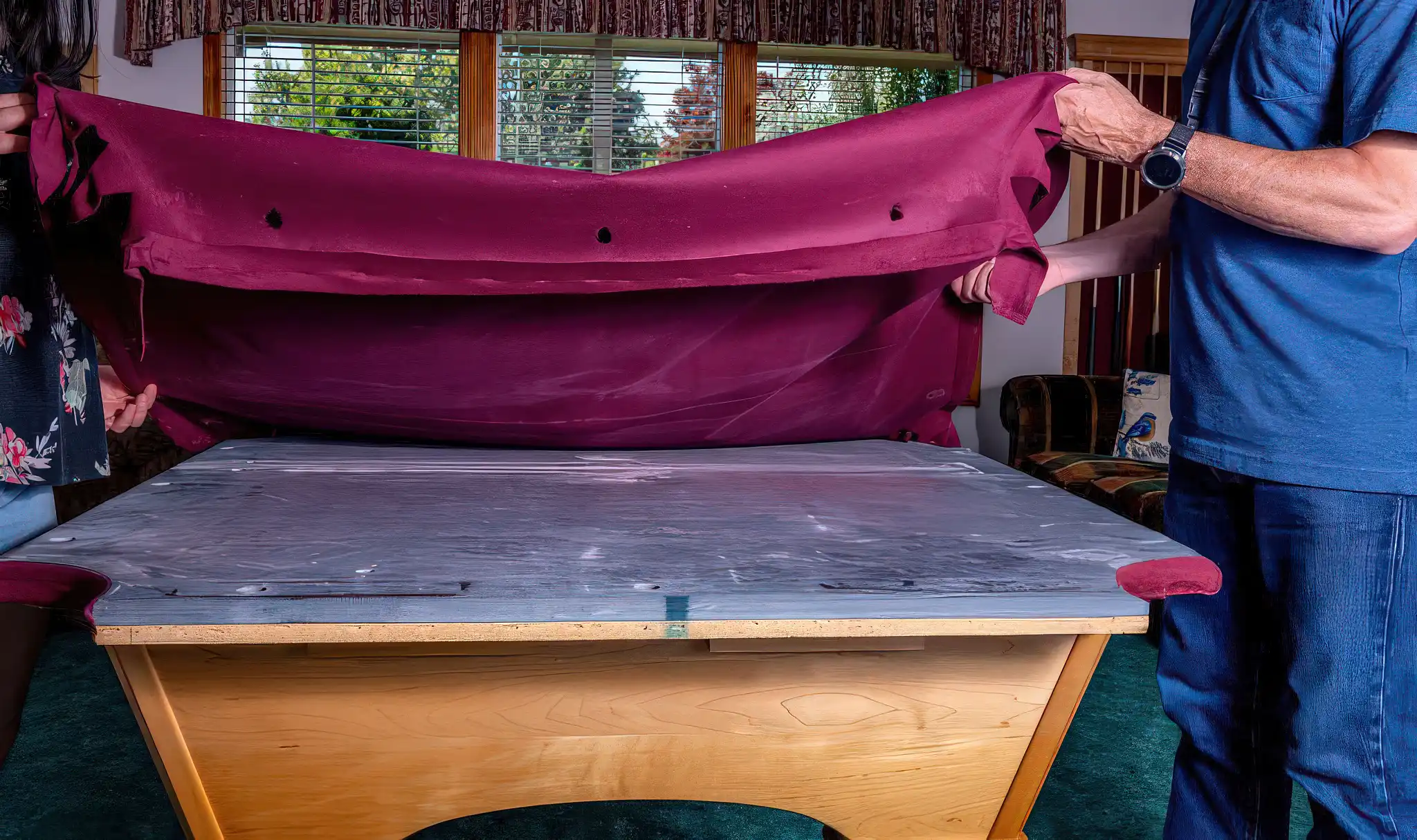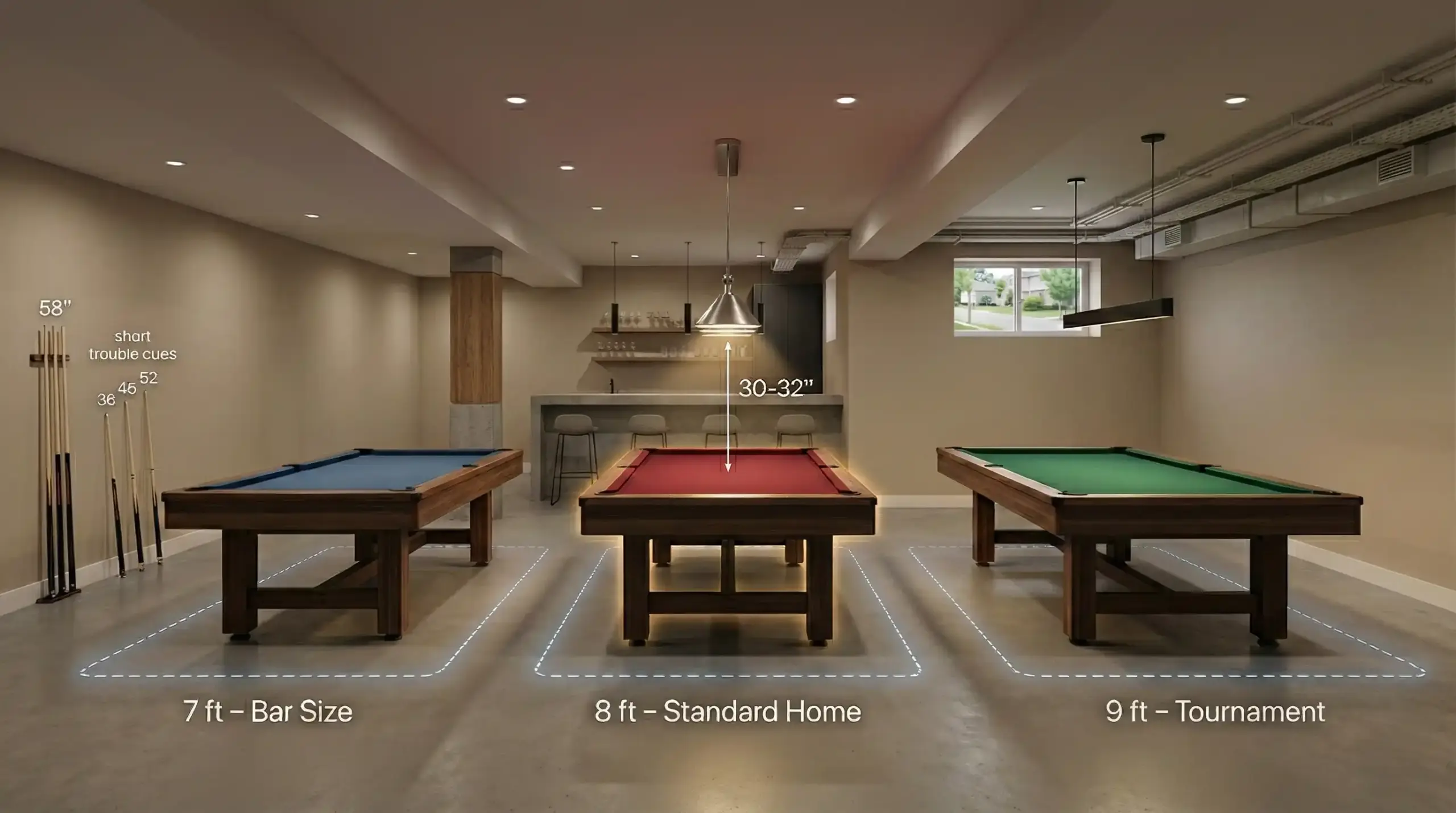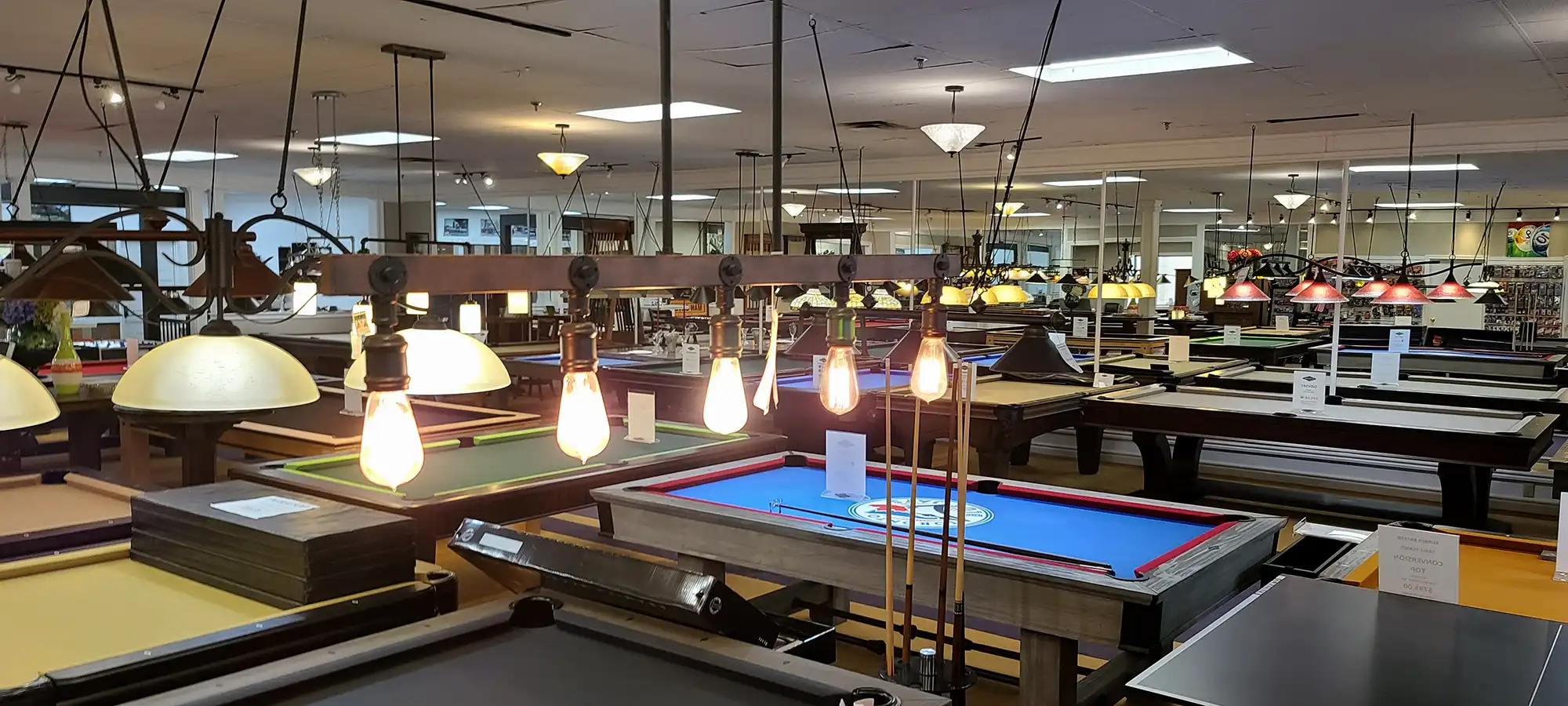A pool table is the heart of a game room, but over time, you might notice your shots aren’t as true as they used to be. Unpredictable ball rolls, dead cushions, and a worn appearance can turn a precision instrument into a source of frustration. This decline is often due to the slow accumulation of dust, chalk, and grime, combined with the natural aging of materials. Neglecting your table doesn’t just affect its look; it directly compromises the quality of play and diminishes its value. This guide provides a comprehensive approach to pool table maintenance and repair, empowering you to protect your investment and ensure it delivers perfect play for years to come.
Key Takeaways
- Consistent, routine cleaning is the most effective way to prevent dust and chalk from damaging the felt and affecting ball roll.
- A perfectly level playing surface is critical for fair play; regular checks and minor adjustments can prevent frustrating ball drift.
- Recognizing the signs of aging in cushions and felt helps you know when professional repair or replacement is necessary to maintain playability.
- While many routine tasks are DIY-friendly, complex jobs like refelting, cushion replacement, and slate repair require a professional technician to avoid costly damage.
- Using a quality table cover is the single most effective way to protect your table from dust, spills, and UV light damage.
What is the Correct Routine for Pool Table Maintenance?
Establishing a consistent maintenance schedule is the key to preventing small issues from becoming major problems. The delicate materials of your table, like the felt and wood finish, require specialized tools and techniques, not generic household cleaners. A dedicated pool table brush, microfiber cloths, and proper cleaning solutions are essential for effective pool table cleaning tools.
After-Play and Weekly Rituals
After every session, you should brush the felt in one direction to remove fresh chalk dust, wipe down the rails, and cover the table. This simple ritual provides crucial protection against the most common sources of wear. On a weekly basis, perform a more thorough brushing under the rails and wipe out the pockets to remove accumulated debris.
Monthly Deep Dive and Component Care
Monthly, it’s time for a deeper dive. Deep clean the pool balls to prevent transferring grime back to the felt. You can wash them with mild soap and water or use a specialized billiard ball cleaner for a better shine. This is also a good time to inspect your cue sticks for worn tips that could damage the felt and to check that the table is still level, as settling can occur. For the wood components, dust regularly and occasionally apply a high-quality furniture polish, always testing it on an inconspicuous area first.
How Do You Properly Go About Cleaning Pool Table Felt?
The felt is the most delicate and critical component for gameplay. Proper cleaning preserves its smoothness and ensures a true ball roll.
Brushing and Vacuuming Techniques
Always use a brush with soft bristles designed specifically for pool tables. The correct technique involves brushing in straight, overlapping lines in one direction, either from the center out or from one end to the other. Never scrub in circles, as this can damage the fibers. Brush the top of the rails first, then the main surface, sweeping debris towards a pocket to be collected. Vacuuming the felt is contentious; while it can remove fine dust, the suction from a standard vacuum can stretch or tear the cloth. If you choose to vacuum, use a low-power handheld model on the lowest setting with a soft, non-rotating brush attachment. However, regular, thorough brushing remains the safest primary method.
A Guide to Spot and Stain Removal
For spills, act immediately. Blot liquids with a clean, absorbent cloth; never rub. If a stain remains, gently blot with a cloth dampened with clean water. For stubborn stains, a highly diluted solution of mild soap or a specialized felt cleaner can be used, but always test it on a hidden spot first. Burn marks from fast-moving balls are generally permanent, but using high-quality phenolic resin balls can help minimize their occurrence.
What is the Best Way of Leveling a Pool Table?
A perfectly level table is the foundation of a fair game. Even a minor tilt can cause balls to drift, undermining skillful play.
How to Check if Your Table is Level
You can check your table’s level using a carpenter’s level, a machinist’s level for greater precision, or even a smartphone app. Place the level lengthwise, crosswise, and diagonally on the playing surface. The bubble should be perfectly centered. A practical test involves gently rolling a ball across the table; it should travel in a straight line without curving.
Adjusting Legs and Using Shims for Balance
If you detect a tilt, the adjustment process is straightforward for most tables. Many modern tables have built-in leg levelers, which are screw-in feet that can be turned to raise or lower a corner. Make small, incremental adjustments, checking the level after each turn. If your table doesn’t have adjustable legs, you will need to use shims—thin pieces of wood, plastic, or even playing cards—placed under the legs to raise them. For multi-piece slate tables, leveling the individual slate pieces is a complex job best left to a professional pool table service.
How Do You Handle Pool Table Cushion Repair?
Cushions provide the energetic rebound essential for strategic play. When they degrade, they become “dead,” absorbing the ball’s energy and leading to weak, unpredictable bounces.
Testing Rail Responsiveness and Identifying Wear
You can test your rails by shooting a ball firmly down the table; it should travel a minimum of four to four-and-a-half lengths. Also, press your fingers into the cushions; they should feel firm but responsive, not rock-hard or mushy. A dull “thud” sound on impact is another sign of dead cushions. Before concluding you need a pool table cushion repair, check for loose rail bolts underneath the table and tighten them, as this is a common cause of poor rebound.
When is Cushion Replacement Necessary?
If the cushions are physically deteriorating—cracked, hard, or inconsistent—they likely need replacement. Cushion rubber typically has a lifespan of 10-15 years for standard quality, though high-end cushions can last much longer. Replacing cushions is a job for a professional. It involves stripping the felt, removing the old rubber, gluing on a new set with the correct profile for your table, and trimming it precisely.
What Is Involved in Pool Table Pocket Repair?
Pockets endure constant abuse. Regular cleaning and inspection can significantly extend their life.
Pocket Cleaning, Conditioning, and Inspection
For leather pockets, periodically use a dedicated leather cleaner and apply a quality conditioner to keep them supple and prevent cracking. For rubber or vinyl pockets, a simple wipe-down with a damp cloth is sufficient. While cleaning, inspect for any signs of wear, such as tears, frayed stitching, or cracks in the liners.
Addressing Minor Pocket Damage
Minor pocket issues can sometimes be addressed. If a pocket is loose, you may be able to tighten accessible screws from underneath the table. However, most pocket replacements are more complex. Significant damage, like large tears or broken mounting hardware, typically requires a professional. For tables with ball return systems, the primary maintenance is keeping the balls themselves clean to prevent grime from building up in the internal tracks.
How Do You Inspect for Pool Table Frame Repair?
The frame and legs are the foundation of your table, providing stability and supporting the immense weight of the slate.
Checking Frame and Leg Integrity
To check for structural soundness, gently try to rock the table; it should be solid with minimal wobble. Visually inspect the frame and legs for any cracks, splits, or warping. Periodically check and tighten any loose bolts or hardware connecting the legs and frame. While tightening hardware is a simple DIY task, any significant pool table frame repair, such as fixing a cracked leg or warped beam, should be handled by an expert.
Understanding and Inspecting Your Slate
The slate is the heart of the playing surface. Inspecting it usually happens during a refelting. Look for any cracks or significant chips. On three-piece slate tables, the seams between the pieces are filled with wax and scraped perfectly smooth. If you can feel a ridge under the felt, a seam may have “popped,” which requires a professional to re-level and reseal. Any and all slate repairs are professional-level jobs.
When Should You Call a Professional Pool Table Service?
Knowing the difference between DIY maintenance and a job for an expert is crucial. Some tasks are perfect for a hands-on owner, while others require specialized tools and experience to avoid costly mistakes. Here’s a quick guide to help you decide when to tackle a job yourself and when to call for a professional pool table service.
| Issue / Task | Recommended Action | Notes & Considerations |
| Routine Cleaning | DIY | Follow correct techniques for brushing felt, cleaning balls, and wiping wood. |
| Minor Stain Removal | DIY | Act quickly, blot (don’t rub), and always test cleaners on a hidden spot first. |
| Basic Table Leveling | DIY | Use leg levelers or shims for minor adjustments. Requires a level and patience. |
| Tightening Hardware | DIY | Simple to do with the correct wrenches or screwdrivers. |
| Full Felt Replacement | Professional | Requires precision stretching for proper tension. High risk of wrinkles and poor playability. |
| Cushion Replacement | Professional | Demands precise alignment, gluing, and trimming for proper and consistent rebound. |
| Slate Repair (Cracks/Chips) | Professional | Requires specialized materials and expertise to ensure a perfectly flat surface. |
| Leveling Slate Seams | Professional | Involves table disassembly and precision tools (machinist’s level) to avoid ridges. |
| Major Structural Damage | Professional | Repairing a broken frame or warped leg is critical for stability and requires expertise. |
| Table Moving & Reassembly | Professional | Essential for safely handling heavy slate and ensuring correct, level setup. |
Frequently Asked Questions (FAQ)
What is the most important part of pool table maintenance?
- The most important and simplest task is to keep the table covered when not in use. A good cover protects the felt from dust, spills, pet hair, and damaging UV sunlight, which prevents the majority of common issues.
How often should I clean the pool balls?
- You should deep clean your pool balls monthly, or more often if they appear visibly dirty or feel grimy. Clean balls prevent the transfer of dirt and oils to the felt, keeping your playing surface in better condition for longer.
Can I use a regular vacuum cleaner on my pool table felt?
- It is not recommended. The powerful suction can stretch or tear the delicate felt fibers. If you must vacuum, use a low-power handheld model on the lowest setting with a soft, non-rotating brush attachment, and proceed with extreme caution. Brushing is the safer method.
My ball doesn’t bounce well off the rails. What’s wrong?
- It could be a few things. First, check that the rail bolts are tight. If they are, the cushion rubber has likely aged and become “dead.” This means it has lost its elasticity and needs to be replaced by a professional.
Is it okay to sit or lean on the pool table?
- No. Sitting or leaning on the rails can cause the cushion rubber to detach from the wood sub-rail, create dead spots, and potentially stress or damage the frame and legs.
Conclusion
Your pool table is an investment in fun and fellowship, and protecting it is straightforward with a commitment to informed care. By following a routine of regular cleaning, checking for levelness, and understanding the needs of each component, you can ensure its longevity and playability. Simple preventative measures, like using a cover and keeping drinks away, go a long way in avoiding costly repairs.
It is also vital to know your limits. While you can confidently handle daily upkeep and minor adjustments, complex tasks like pool table refelting, cushion replacement, and slate repair are best left to qualified technicians. By embracing a consistent maintenance schedule and calling in experts when needed, you ensure your table remains a beautiful centerpiece and a precision instrument, always ready for the next perfect game.
For professional services or expert advice, contact Pool Table Store today.





